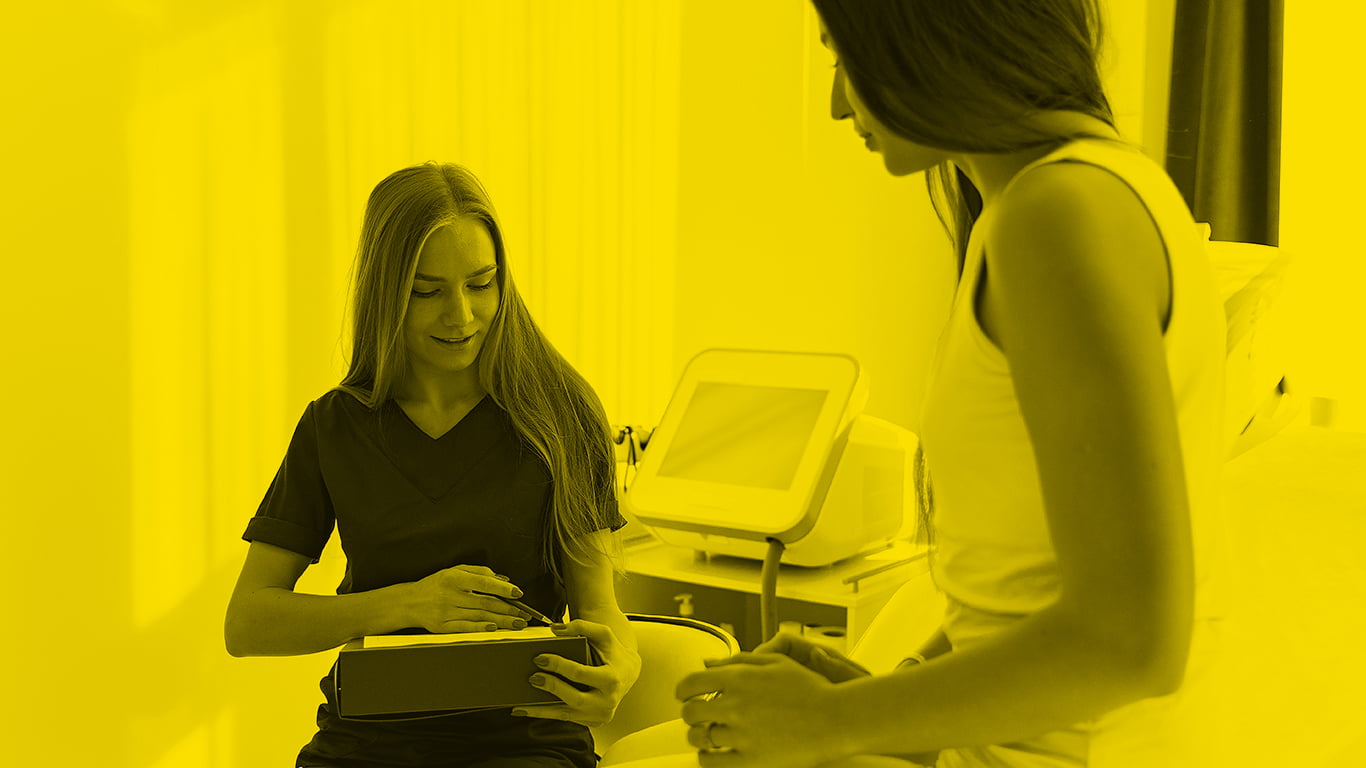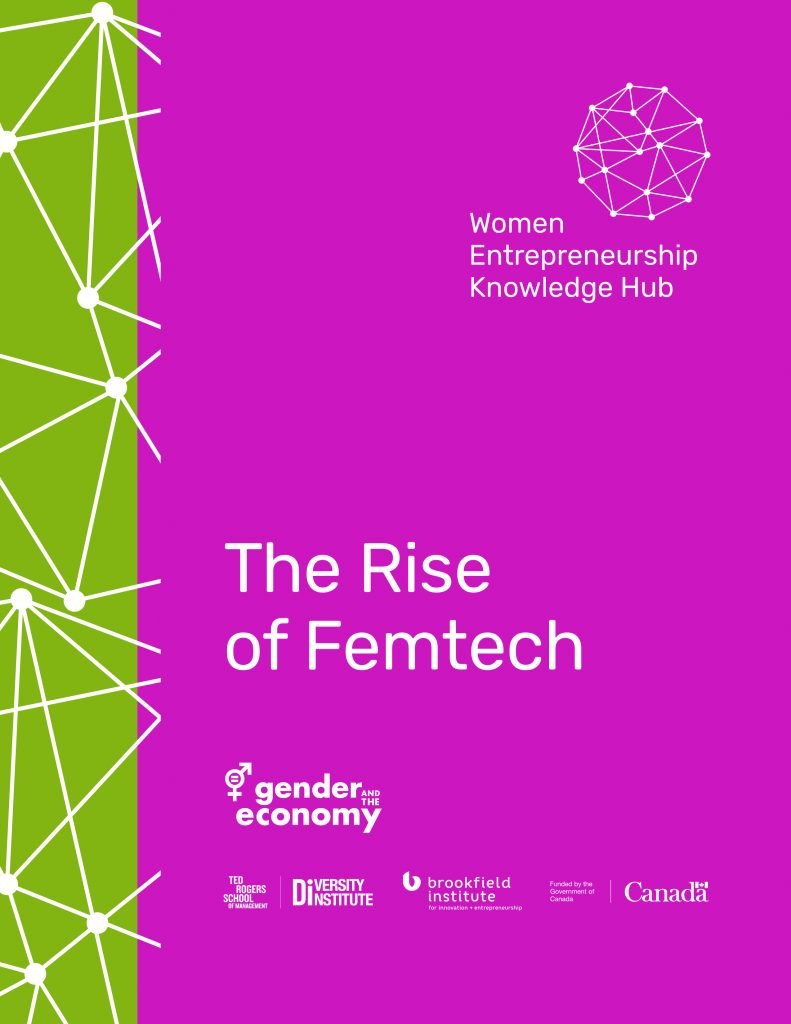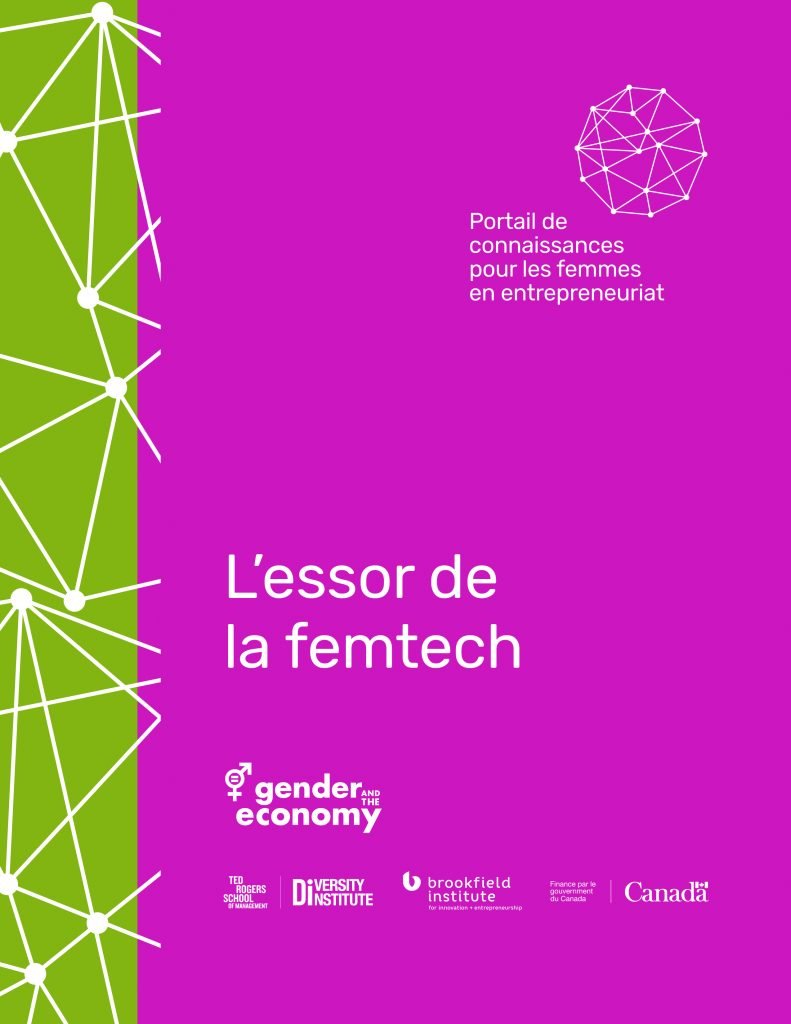Download this research brief (in English/en Français).
Overview
In the last decade, we have seen a rise in businesses leveraging technology to offer products and services dedicated to “improving” women’s health. This new market segment has been dubbed femtech, and, according to Frost & Sullivan, it has the potential to reach $50B by 2025.[1] Because femtech is relatively new, there is little empirical research about it. However, the topic has received a great deal of attention from the popular press, and we can also learn from prior work in other cognate areas (e.g., gender diversity and innovation). This research overview provides a brief history of femtech and a summary of the existing academic work and industry research. Below, we begin by defining femtech, describing the importance of this new term—including backlash to it—and discussing what femtech signals about entrepreneurship, technology, and women’s health more broadly.
What counts as femtech?
When people talk about femtech, they are referring to a subset of medical technology (or medtech) products and services addressing issues historically and conventionally associated with the reproductive health of cisgender women.[2] That is, the vast majority of femtech addresses issues like contraception and fertility, pregnancy and post-pregnancy, breastfeeding, menstruation and period care, pelvic health, menopause, hormonal disorders (e.g., polycystic ovary syndrome), and sexual wellness. Some femtech companies—such as Maven, a virtual clinic for women—also address women’s health in general.
Examples of femtech products and services include:
- Clue. A mobile menstrual health app created by Berlin-based BioWink GmbH, a company co-founded by Ida Tin in 2013. As of 2019, Clue has raised $29.7M.[3]
- Glow. A mobile fertility app created by a data science company of the same name, co-founded in 2013 by Max Levchin, former co-founder of PayPal. As of 2019, Glow has raised $23M.[4]
- Natural Cycles. The first FDA approved fertility tracking app created by CB Rank, co-founded in 2013 by CERN physicist Dr. Elina Berglund and her husband Dr. Raoul Scherwitzl. As of 2019, Natural Cycles has raised $37.5M.[5]
- Ava. Established in 2014 by Lea von Bidder, Pascal Koenig, Peter Stein, and Philipp Tholen, Ava is a bracelet that monitors five “physiological signals of fertility” and then displays the real-time data via a mobile app. As of 2019, Ava has raised $42.4M.[6]
- Lola. Established in 2014 by co-founders Alexandra Friedman and Jordana Kier, Lola offers a subscription service for menstrual products (e.g., pads, tampons, essential oil for menstrual cramps) and sexual health products (e.g., condoms, lubricant). As of 2019, Lola has raised $35.2M.[7]
- Lia offers the first biodegradable and flushable at-home pregnancy test. Co-founded by Bethany Edwards and Sarah Rottenberg in 2015, as of 2019, Lia has raised $2.6M.[8]
- Co-founded by Eric Dy and Julien Penders in 2014, Bloomlife is a wearable tracking device that monitors contractions, displaying real-time data via a mobile app. As of 2019, Bloomlife has raised $14.4M.[9]
- Creators of a Kegel trainer and breast pump, Elvie was co-founded in 2013 by Alexander Asseily and Tania Boler and has, as of 2019, raised $53.8M.[10]
Who’s behind femtech?
Ida Tin, a Danish entrepreneur and the co-founder and CEO of Clue, coined the term femtech in 2016 to describe the proliferation of women’s health products she’d noticed in the market and to mitigate men’s discomfort with discussing issues like incontinence and menstruation. As Tin explained during a 2018 Geekettes panel: “Then, investors can say, ‘I have four FemTech companies in my portfolio’ instead of ‘I have a company for women peeing in their pants.’ That’s hard for a male investor to say.”[11]
The origins of the word femtech tell us several things. First, the advent of femtech signals unmet needs and corresponding opportunities in the marketplace. Second, Tin’s coining of femtech signals the female anatomy continues to be stigmatized[12] and women’s health continues to suffer from sexism.[13] [14] Relatedly, Tin’s reasoning (“That’s hard for a male investor to say”) signals the majority of investors who have the capital to fund start-ups continue to be men.
Canadian femtech start-ups like Eve Medical, Damiva, Elvie, and Knix Wear—all of which were started by women—have also become prominent players in the femtech space. Although there’s a lot of speculation (and a growing amount of evidence) that femtech companies are more likely to be founded and funded by women, to date there has been very little academic research about femtech products, services, and entrepreneurs. Important exceptions include Sarah Fox’s 2018 dissertation in which she “examines recent industry and policy initiatives aimed at extending menstrual resources,” briefly touching on the work of social entrepreneurs in the menstrual product space.[15] However, a few femtech founders have published books about their experiences as women entrepreneurs. For example, Miki Agrawal, the controversial co-founder and former CEO of THINX, published DO COOL SH*T: Quit Your Day Job, Start Your Own Business and Live Happily Ever After in 2013 and DISRUPT-HER: A Manifesto for the Modern Woman in 2019.
Critiques of femtech products and services
Early critiques of femtech include Maggie Delano’s 2015 Medium article entitled “I tried tracking my period and it was even worse than I could have imagined.”[16] Delano describes how—as a queer woman with irregular periods who is not interested in having children—she felt “erased” by the apps she tried. Since 2015, the backlash against femtech has become more widespread with others echoing Delano’s observations[17], asking whether the term femtech pigeonholes women’s health[18] and essentializes women to reproductive biological functions while simultaneously excluding non-binary and trans users.[19] Critics have also asked why there is no “MenTech”—that is, why are cisgender men considered the “average user” for any given technology? Consider that menstrual tracking apps were created largely in response to Apple’s initial failure to include menstruation in HealthKit (now known simply as Health).[20] Finally, feminists and practitioners alike have expressed concerns about how femtech products exploit women’s anxieties and fears for profit.[21] For example, in her 2019 book The Vagina Bible, Jen Gunter, an OB/GYN and pain medicine physician, argues Kegel trainers and vaginal steams not only reinforce “vagina shame,” they are also unnecessary and potentially dangerous.[22]
What the academic research says about femtech
Academic research about femtech has primarily fallen outside of traditional management scholarship, being dominated by those in the human computer interaction (HCI) field.
Experimental designs and protypes
In the past five years, a small group of human computer interaction (HCI) researchers and designers have begun to design and build femtech prototypes solely for research purposes. For example, Almeida and colleagues created Labella, “an augmented system that supports intimate bodily knowledge and pelvic fitness in women” via a pair of underwear and a mobile phone[23] while Schneider and colleagues created and tested a prototype of a fertility tracking app (FTA) to explore how technology might handle uncertainty without negative emotional effects.[24] In general, these experimental designs and prototypes have been vehicles for exploring concepts (e.g., self-knowledge, uncertainty, data practices) relevant to HCI in general. [25],[26]
Critiques of existing femtech products
Other HCI researchers have interrogated and critiqued existing femtech products on the market to ask how well these products meet users’ needs. In their survey and interview-based study with users of period tracking apps, Epstein and colleagues found apps were ineffective when it came to predicting cycles and that designs of apps can create feelings of exclusion for some users. [27] Similarly, in a heuristic evaluation of 17 menstrual tracking apps, Eschler and colleagues found the majority of apps they tested did not account for users experiencing menarche and menopause. [28]
Concerns about data security, privacy, and surveillance
Sociologists and legal scholars have also critiqued existing digital health technologies marketed to women, asking how they reinforce gendered norms and offer ways for the body to be subject to surveillance. [29],[30],[31] For example, Karen Levy writes about different kinds of intimate surveillance including fertility tracking, noting that some fertility apps (i.e., Glow) encourage partners to set up “mirror” apps so that they can monitor moods and even provide “objective” readings of dispositions.[32] Similarly, Deborah Lupton has written about the “caring dataveillance” enacted by mothers who use tracking technologies to monitor their pregnancies and, later, their children.[33]
Questions about whether femtech products and services improve health-related outcomes
Finally, HCI and health informatics researchers have asked whether digital femtech products are based on evidence-based medical practices and can actually improve health-related outcomes. Lee & Kim argue that the results of their double-blind randomized control trial of two different menstrual tracking apps indicate that some such apps may result in the “possibility of behavioral and cognitive changes in dysmenorrhea and PMS management.” [34] To date the adoption, use, and efficacy other kinds of femtech products and services have been understudied.
Gender diversity and innovation
One of the questions researchers across disciplines have asked is whether gender diversity impacts innovation.[35],[36] For example, a study of 1,648 Danish firms found firms with more balanced gender compositions were more likely to innovate than firms with a higher concentration of one gender.[37] We know from prior work—and from industry examples like Apple’s failure to include menstruation in its earliest versions of Health—that gender is often not a factor explicitly considered during product design.[38],[39] We also know that when gender has been considered, design choices have reinforced stereotypes: for example, the “shrink it and pink it” phenomenon.[40] Some press pieces argue that men—rather than women—design the products and applications dominating femtech.[41] However, as noted above, there has yet to be any academic research done in this space.
What industry research says about femtech
Industry research about medtech indicates healthcare is becoming more “consumer-centric” in general.[42] While femtech has received less attention from industry researchers, many of the general observations about medtech also hold true for femtech. However, reports about femtech tend to consider more specific markets. For example:
- I See Africa, “a content hub of curated, informative, relevant information” about trends in Africa, released a report in 2019 about the ways in which femtech in Africa is addressing menstrual equity, pregnancy care, and sexual wellness.[43]
- Modern Fertility, Her, and researcher Mere Adams released a report based on survey data about the state of “LGBTQ+ fertility” in 2019. In it, they note the fertility information gap and subsequent use of social media to address this gap, challenges with traditional healthcare, enthusiasm towards at-home fertility tests, and the anxiety triggered by fertility concerns.[44]
In summary, the modest amount of industry research available about femtech indicates that some products and services may be able to address the needs of consumers who have historically been marginalized by mainstream markets, medical institutions, and practices.[45]
What we still don’t know about femtech
Because the rise of femtech is such a recent phenomenon, there is still much we do not know. Future academic research might ask questions about:
- The demographics and motivations of femtech founders and investors. Who are femtech founders and what motivates them to start companies in this space? What kinds of barriers do they face and how do they overcome these barriers? How does entrepreneurship in this space compare to entrepreneurship in other industries and market segments? Are women more likely than men to start and/or invest in femtech ventures?
- The role of gender diversity in innovation. How is gender diversity important in this space? Are women more likely to create innovative products that address women’s health concerns? Does one need to be a woman to disrupt women’s health?
- The role of social entrepreneurship in femtech. Are femtech founders more likely to make social good a key part of their businesses as some popular media pieces have assumed?[46] If so, how does this impact their business strategies and their success?
- Global femtech markets and consumers. How do femtech solutions for girls and women in poorer countries compare to those in wealthier countries? Do femtech markets and consumers differ across the globe? If so, how and why?
- The design and execution of femtech products and services, particularly with regard to evidence-based medical practices. How do femtech products and services incorporate evidence-based medical practices? Do femtech products and services improve health-related outcomes?
- Femtech and health disparities. What kinds of conceptualizations of the body do femtech founders employ in the design and execution of their products and services? How do femtech products and services contribute to existing health disparities? Relatedly, do they create new ones?
- The necessity and efficacy of femtech products and services. Is femtech truly radical, or yet another way to “shrink it and pink it”? If the femtech market becomes dominated by women entrepreneurs, investors, and designers, will we see new innovations that break with old stereotypes?
Returning to the question we posed above regarding whether femtech is an innovative and disruptive space for women’s health or simply a buzzword, the answer is clear: femtech is more than a buzzword. But it is too early for us to understand how much more. We do not yet know all of the potential promises—and pitfalls—of technologies designed, produced, and marketed to “improve” women’s health. This, then, is an area for ample future work across a range of scholarly disciplines.
__________________________
Research overview prepared by:
Dr. Amanda Menking, under the supervision of Professor Sarah Kaplan, Director, Institute for Gender and the Economy at the University of Toronto’s Rotman School of Management.
The preparation of this research overview was supported by the Government of Canada’s Women Entrepreneurship Knowledge Hub (WEKH).
Cite as:
Menking, Amanda (2020), “The Rise of Femtech,” Institute for Gender and the Economy, https://www.gendereconomy.org/the-rise-of-femtech.
References
[1] Femtech: Time for a digital revolution in the women’s health market. (2018, January 31). Frost & Sullivan. Report. Retrieved from https://ww2.frost.com/frost-perspectives/femtechtime-digital-revolution-womens-health-market/
[2] There has been little to no attention or research on how these concerns are relevant for transgender men.
[3] Clue. Crunchbase. Retrieved from https://www.crunchbase.com/organization/clue
[4] Glow. Crunchbase. Retrieved from https://www.crunchbase.com/organization/glow
[5] Natural Cycles. Crunchbase. Retrieved from https://www.crunchbase.com/organization/naturalcycles
[6] Ava. Crunchbase. Retrieved from https://www.crunchbase.com/organization/ava-3
[7] Lola. Crunchbase. Retrieved from https://www.crunchbase.com/organization/lola
[8] Lia. Crunchbase. Retrieved from https://www.crunchbase.com/organization/lia-diagnostics
[9] Bloomlife. Crunchbase. Retrieved from https://www.crunchbase.com/organization/bloom-technologies
[10] Elvie. Crunchbase. Retrieved from https://www.crunchbase.com/organization/chiaro-technology-ltd
[11] Weiss, S. (2018, April 16). What is FemTech? 5 things to know about the new industry. Bustle. Retrieved from https://www.bustle.com/p/what-is-femtech-5-things-to-know-about-the-new-industry-8792289
[12] Braun, V., & Wilkinson, S. (2001). Socio-cultural representations of the vagina. Journal of Reproductive and Infant Psychology, 19(1), 17-32.
[13] Hughes, F., & Bernstein, P. S. (2018). Sexism in obstetrics and gynecology: not just a “women’s issue”. American Journal of Obstetrics and Gynecology, 219(4), 364-e1.
[14] Homan, P. (2019). Structural sexism and health in the United States: a new perspective on health inequality and the gender system. American Sociological Review, 84(3), 486-516.
[15] Fox, S. (2018). Maintaining the Menstruating Body: Feminist Interventions on Care Resources. Dissertation. DOI: http://hdl.handle.net/1773/42879
[16] Delano, M. (2015, February 23). I tried tracking my period and it was even worse than I could have imagined. Medium. Retrieved from https://medium.com/@maggied/i-tried-tracking-my-period-and-it-was-even-worse-than-i-could-have-imagined-bb46f869f45
[17] Tiffany, K. (2018, November 16). Period-tracking apps are not for women. Vox. Retrieved from https://www.vox.com/the-goods/2018/11/13/18079458/menstrual-tracking-surveillance-glow-clue-apple-health
[18] Kleinman, Z. (2019, October 8). Femtech: right time, wrong term? BBC News. Retrieved from https://www.bbc.com/news/technology-49880017
[19] Goldhill, O. (2019, April 3). “FemTech” is not and should not be a thing. Quartz. Retrieved from https://qz.com/1586815/why-femtech-is-a-sexist-category/
[20] Duhaime-Ross, A. (2014, Sept. 25). Apple promised an expansive health app, so why can’t I track menstruation? The Verge. Retrieved from https://www.theverge.com/2014/9/25/6844021/apple-promised-an-expansive-health-app-so-why-cant-i-track
[21] Altman, A. (2019, January 14). Mommy and data. The New Republic. Retrieved from https://newrepublic.com/article/152693/femtech-companies-alleviate-exploit-female-anxiety
[22] Gunter, J. (2019). The Vagina Bible: The Vulva and the Vagina: Separating the Myth from the Medicine. Citadel Press.
[23] Almeida, T., Wood, G., Comber, R., and Balaam, M. 2016. Interactivity: looking at the vagina through Labella. In Proceedings of the 2016 CHI Conference Extended Abstracts on Human Factors in Computing Systems (CHI EA ’16). ACM, New York, NY, USA, 3635-3638. DOI: https://doi.org/10.1145/2851581.2890261
[24] Schneider, H., Wayrauther, J., Hassib, M. and Butz, A. 2019. Communicating uncertainty in fertility prognosis. In Proceedings of the 2019 CHI Conference on Human Factors in Computing Systems (CHI ’19). ACM, New York, NY, USA, Paper 161, 11 pages. DOI: https://doi.org/10.1145/3290605.3300391
[25] Fox, S., Howell, N., Wong, R., & Spektor, F. (2019, June). Vivewell: speculating near-future menstrual tracking through current data practices. In Proceedings of the 2019 on Designing Interactive Systems Conference (pp. 541-552). ACM, New York, NY, USA, 541-552. DOI: https://doi.org/10.1145/3322276.3323695
[26] Bardzell, J., Bardzell, S., Lazar, A. & Makoto Su, N. (2019). (Re-)framing menopause experiences for HCI and design. In Proceedings of the 2019 CHI Conference on Human Factors in Computing Systems (CHI ’19). ACM, New York, NY, USA, Paper 115, 13 pages. DOI: https://doi.org/10.1145/3290605.3300345
[27] Epstein, D., Lee, N.B., Kang, J.H., Agapie, E., Schroeder, J., Pina, L.R., Fogarty, J., Kientz, J.A., and Munson, S. 2017. Examining menstrual tracking to inform the design of personal informatics tools. In Proceedings of the 2017 CHI Conference on Human Factors in Computing Systems (CHI ’17). ACM, New York, NY, USA, 6876-6888. DOI: https://doi.org/10.1145/3025453.3025635
[28] Eschler, J., Menking, A., Fox, S., & Backonja, U. (2019). Defining menstrual literacy with the aim of evaluating mobile menstrual tracking applications. CIN: Computers, Informatics, Nursing, 37(12), 638-646.
[29] Lupton, D. (2014). Critical perspectives on digital health technologies. Sociology Compass, 8(12), 1344-1359.
[30] Wissinger, E. (2017). Wearable tech, bodies, and gender. Sociology Compass, 11(11), e12514.
[31] Rosas, C. (2019). The future is femtech: privacy and data security issues surrounding femtech applications. Hastings Business Law Journal, 15(2), 319.
[32] Levy, K. E. (2014). Intimate surveillance. Idaho Law Review, 51(3), 679-694.
[33] Lupton, D. (2019). Caring dataveillance: women’s use of apps to monitor pregnancy and children. The Routledge Companion to Digital Media and Children. Abingdon-on-Thames: Routledge.
[34] Lee, J., & Kim, J. (2019). Can menstrual health apps selected based on users’ needs change health-related factors? A double-blind randomized controlled trial. Journal of the American Medical Informatics Association, 26(7), 655-666.
[35] Ding, W. W., Murray, F., & Stuart, T. E. (2013). From bench to board: gender differences in university scientists’ participation in corporate scientific advisory boards. Academy of Management Journal, 56(5), 1443-1464.
[36] Díaz-García, C., González-Moreno, A., & Jose Sáez-Martínez, F. (2013). Gender diversity within R&D teams: its impact on radicalness of innovation. Innovation, 15(2), 149-160.
[37] Østergaard, C. R., Timmermans, B., & Kristinsson, K. (2011). Does a different view create something new? The effect of employee diversity on innovation. Research Policy, 40(3), 500-509.
[38] Dray, S.M., Busse, D.K., Brock, A.M., Peters, A.N., Bardzell, S., Druin, A., Burnett, M.M., Churchill E.F., Williams, G., Holtzblatt, K., & Murray, D. (2014). Perspectives on gender and product design. In CHI ’14 Extended Abstracts on Human Factors in Computing Systems (CHI EA ’14). ACM, New York, NY, USA, 53-56. DOI: https://doi.org/10.1145/2559206.2559218
[39] Metaxa-Kakavouli, D., Wang, K., Landay, J.A., & Hancock, J. (2018). Gender-inclusive design: sense of belonging and bias in web interfaces. In Proceedings of the 2018 CHI Conference on Human Factors in Computing Systems (CHI ’18). ACM, New York, NY, USA, Paper 614, 6 pages. DOI: https://doi.org/10.1145/3173574.3174188
[40] Van Tilburg, M., Lieven, T., Herrmann, A., & Townsend, C. (2015). Beyond “pink it and shrink it” perceived product gender, aesthetics, and product evaluation. Psychology & Marketing, 32(4), 422-437.
[41] Ayers, R. (2019, September 26). The rise of “menstrual surveillance” and the fight for data privacy in women’s health. Dataconomy. Retrieved from https://dataconomy.com/2019/09/the-rise-of-menstrual-surveillance-and-the-fight-for-data-privacy-in-womens-health/
[42] Betts, D. & Korenda, L. (2019, November 21). A consumer-centered future of health. Deloitte. Retrieved from https://www2.deloitte.com/us/en/insights/industry/health-care/global-health-care-trends-survey.html
[43] FemTech: eHealth for women. (2019). I See Africa. Report. Retrieved from http://iseeafrica.co.za/wp-content/uploads/2019/11/fem-tech-final-report.pdf
[44] Modern state of LGBTQ+ fertility 2019. (2019). Modern Fertility. Report. Retrieved from https://modernfertility.com/lgbtq-fertility-survey-2019/
[45] Bird, J. (2019, November 28). ‘Femtech’ adapted to benefit women and girls in poorer countries. Financial Times. Retrieved from https://www.ft.com/content/a7a79e1e-f630-11e9-bbe1-4db3476c5ff0
[46] Jones, N. (2018, November 8). Women’s health start-ups bloom with no blushes. Financial Times. Retrieved from https://www.ft.com/content/de0f5b8c-dec0-11e8-b173-ebef6ab1374a
Research summary prepared by
Amanda Menking
Published
November, 2020









